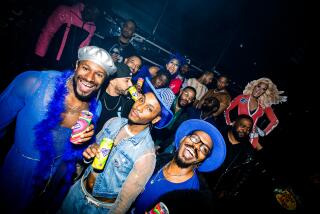Ballroom’s time to shine: ‘Pose’ choreographers Leiomy Maldonado and Danielle Polanco on bringing the ball to life
The first scene in the premiere of FX’s critically acclaimed and groundbreaking drama “Pose” is a high-energy trip into the underground world of New York City’s ballroom culture in the 1980s.
After swiping garbage bags full of gowns, crowns, jewels and fur coats from a museum, Elektra Abundance (played by Dominque Jackson) leads a group of proteges to a ball — a competition and safe haven for LGBTQ people of color that celebrates originality and extravagance.
There is a competition among groups of men and women to see who can best embody royalty. Elektra’s group sashays, twirls and poses on a wood-paneled floor surrounded by an audience that cheers them on. In their stolen, authentic aristocratic wear they easily earn perfect 10s from the judges.
It’s the first of many balls shown in “Pose,” which concludes its first season Sunday.
To capture the true essence of ballroom culture, creators Ryan Murphy, Steven Canals and Brad Falchuk assembled the largest cast of transgender actors in leading roles in a TV series, multiple consultants who lived through the 1980s ballroom and a creative team that included trans activist and writer Janet Mock, trans writer-director Silas Howard and trans producer-writer Our Lady J.
Getting the crucial ball scenes just right also meant employing world-renowned vogue choreographers Leiomy Maldonado, a transgender woman known as the “Wonder Woman of Vogue,” and Danielle Polanco. The choreographers worked extensively with the cast and creative team to represent ballroom in an original yet authentic way.
“I know how things get watered down, and I really didn’t want that to happen to the ballroom,” Polanco said.
The history of ballroom culture traces back to New York City’s drag balls in the 19th and 20th centuries. After facing discrimination and rejection from white gay spaces, black drag queens began forming their own communities and performance gatherings, eventually creating a ballroom scene that still thrives today.
In general, ballroom culture consists of “houses” and balls.
Houses, often named after fashion designers, served as familial structures for gay and transgender black and Latinx youth, many of whom faced rejection from their biological families. Balls are performance-focused gatherings, welcoming spaces for men and women of color from across the gender and sexuality spectrum.
Balls were also the birthplace of vogue, an improvisational dance form that mixes exaggerated model poses; fluid, mime-like movement; and acrobatics.
Ballroom “gave us a sense of belonging,” said Luis Camacho, a 48-year-old choreographer who came of age in the 1980s ballroom scene.
Camacho and Jose Gutierez, both members of the House of Xtravaganza, are credited with introducing Madonna to the ballroom scene. The two also choreographed and starred in the Queen of Pop’s 1990 “Vogue” video, which brought ballroom culture to the masses.
“It gave us empowerment…. It gave us an outlet to be creative and express ourselves,” Camacho said.
Polanco, 32, and Maldonado, 31, met in New York’s ballroom scene in the early 2000s. Although they came from different dance backgrounds, they each found rapid success as voguers, eventually teaching the dance style across the U.S. and around the world.
For both, working on “Pose” was an opportunity to bring the spotlight to real-life stars in the ballroom community. Respected voguers such as Jason A. Rodriguez, known as Slim Ninja, were hired to help bring the show’s ball scenes to life.
“We’re trying to keep it in the family and make the ballroom community stand out,” Polanco said. “There’s not really a spot for ballroom people in the real world, sometimes.”
“A lot of times, people don’t know what our community has gone through,” Maldonado said. “They hear about ballroom, they think it’s fun and cool and exciting. It’s more than that. It’s a part of everything that we stand for, everything that we have to fight for.”
As dancers who came up in 2000s ballroom, Maldonado and Polanco did extensive research to choreograph for the show, which is set in the late 1980s. Like the show’s costume designers, they looked to documentaries such as Jennie Livingston’s “Paris is Burning” and Diane Martel’s “House of Tres.”
“It’s hard because there’s not a lot of footage of things back then,” Polanco said. “On YouTube, you can’t find balls from the ’80s, you could only go off of people’s stories and how people used to dance back then.”
The choreographers worked with the cast for months to prepare them for filming. Though Jackson, who plays Elektra Abundance, was already an icon in the ballroom scene, others were not as familiar with the technique.
More than teaching individual steps, Maldonado and Polanco trained the cast how to improvise. They prepared actors to compete in the wide range of real-life ball categories shown in the series, including “runway” — being able to strut like supermodel Naomi Campbell, who perfected her signature walk with vogue pioneer Willi Ninja. Other categories are rooted in “realness,” which relies on the performer’s ability to convince onlookers that they are something they may not be.
“It’s really important to know how to pose and knowing musicality,” Polanco said. “Knowing how to dip, knowing how to catwalk, knowing hands performance and floor performance — there’s many elements to it.”
The attention to detail has paid off for Camacho. “What ‘Pose’ is doing and what they’re presenting is really, really close to what was happening back then,” he said.
For Maldonado, the most important aspect of working on the series was the opportunity to bring visibility to a community that has often been pushed to the margins.
“ ‘Pose’ overall has been able to showcase the LGBT community in a way where people can see that we are also talented,” Maldonado said. “We can do anything just like any other person.”
Twitter: @makedaeaster
More to Read
The biggest entertainment stories
Get our big stories about Hollywood, film, television, music, arts, culture and more right in your inbox as soon as they publish.
You may occasionally receive promotional content from the Los Angeles Times.










